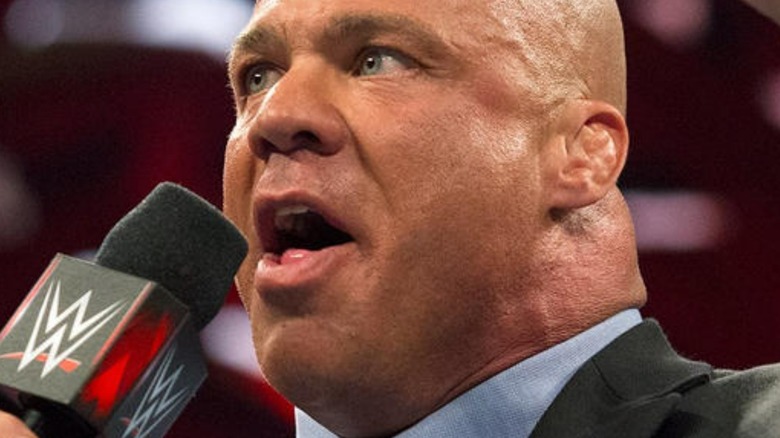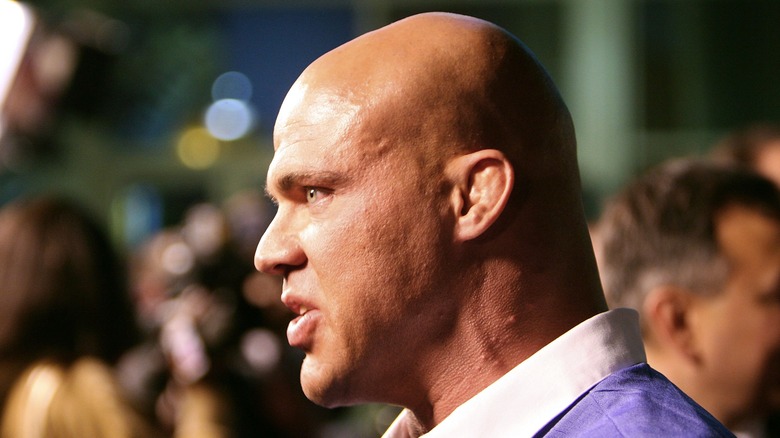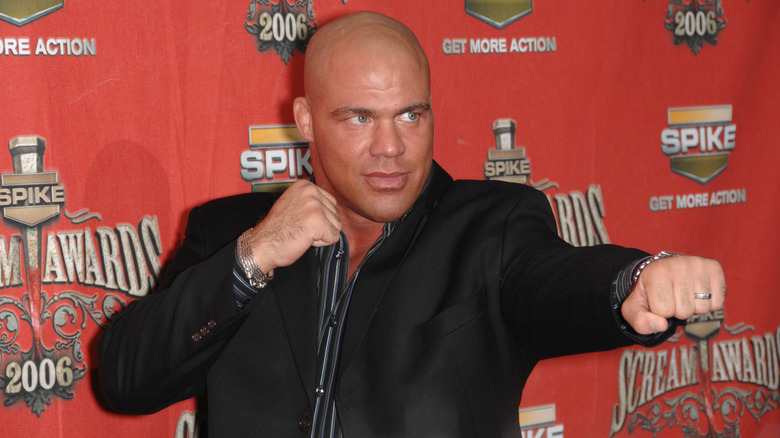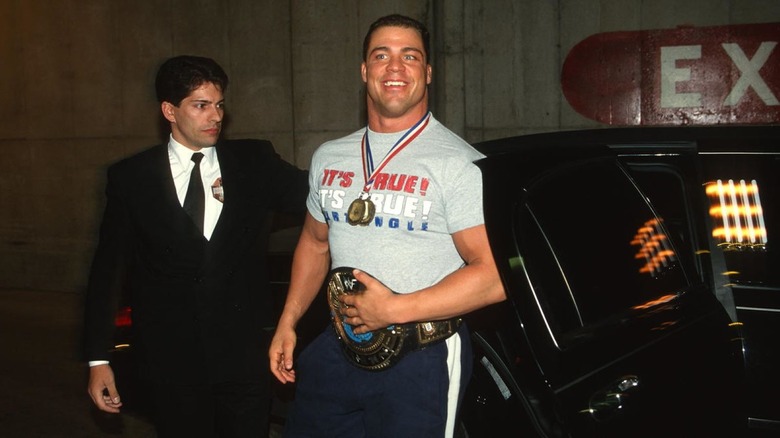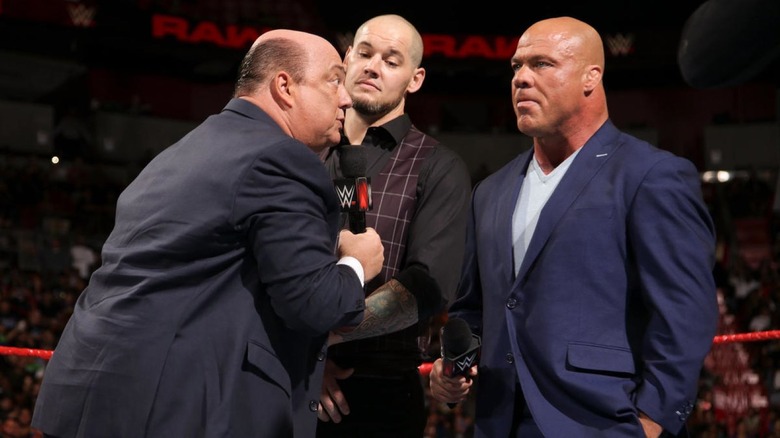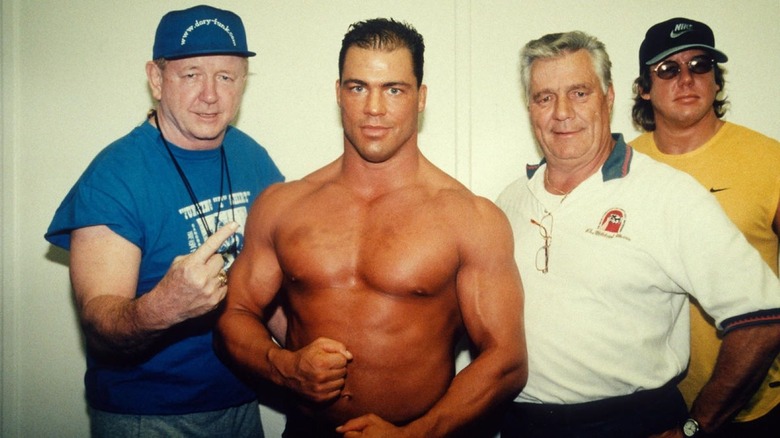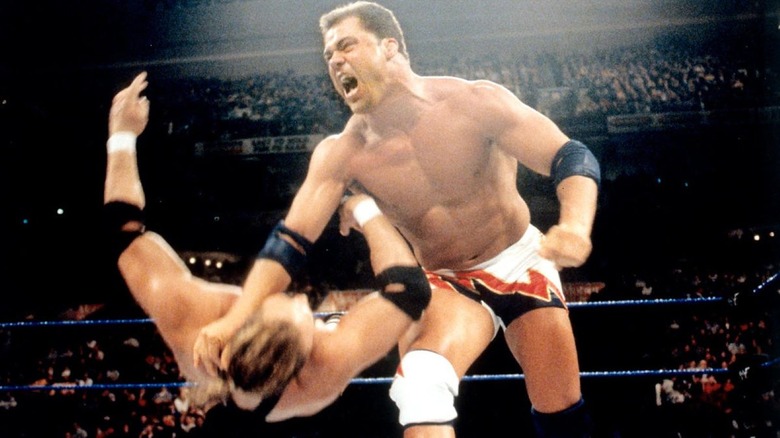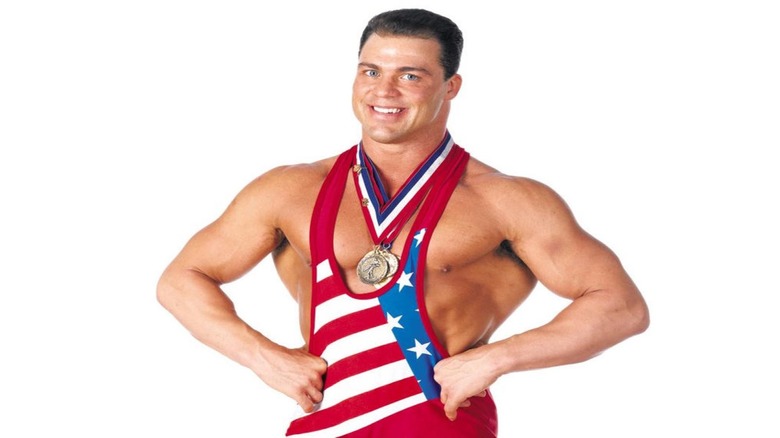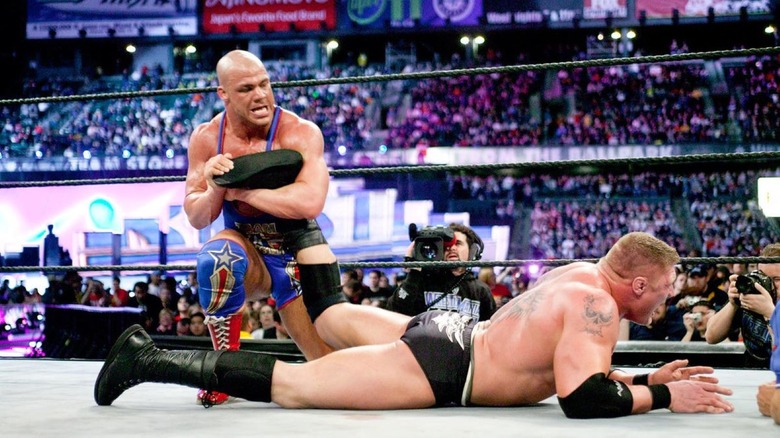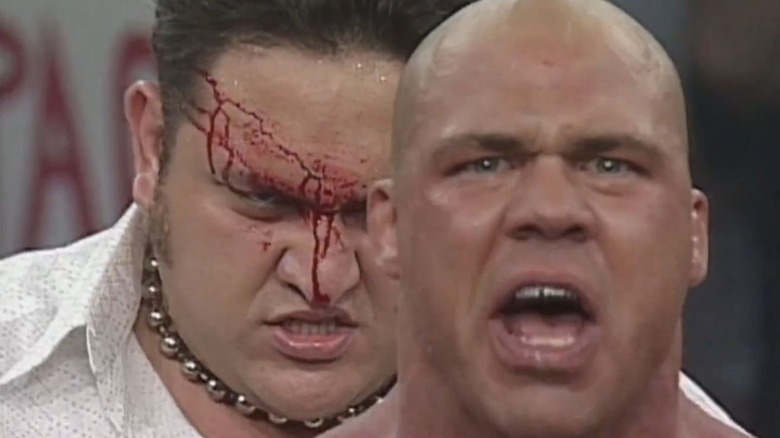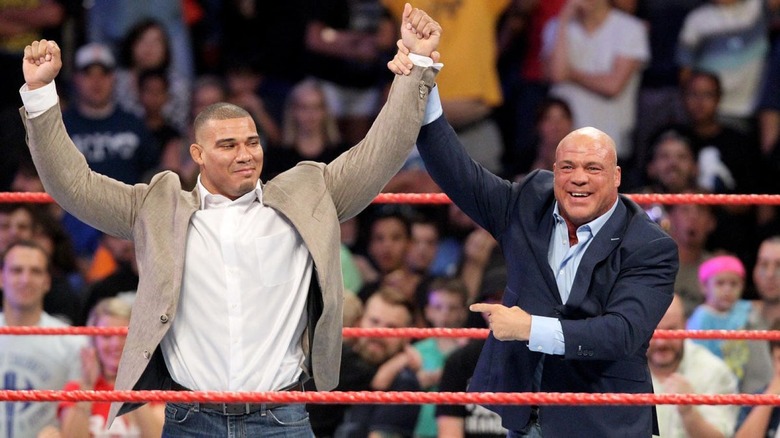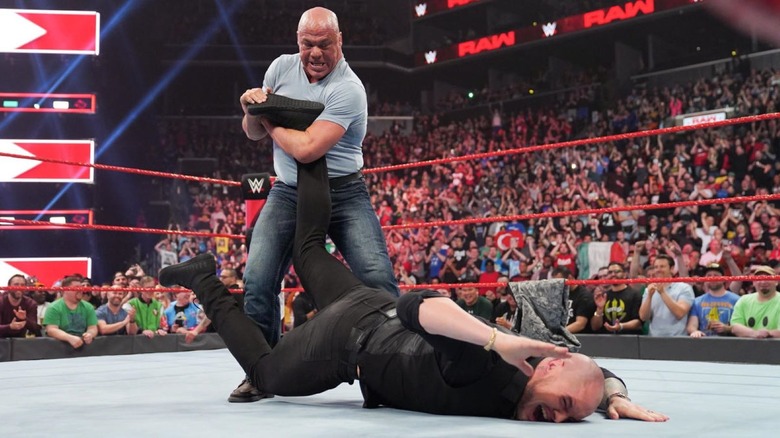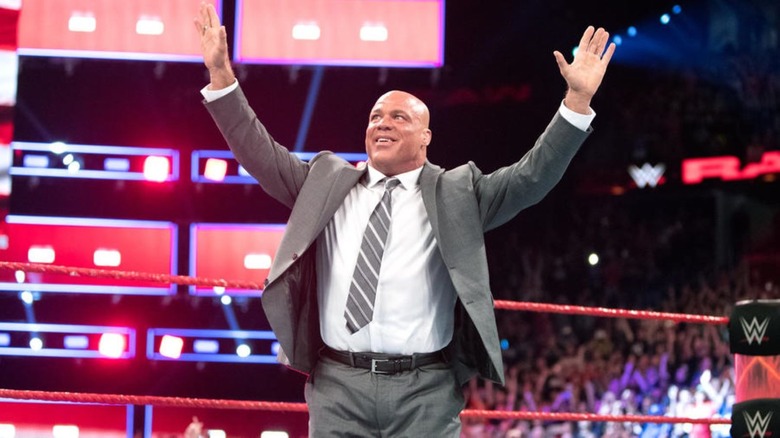How Kurt Angle Went From Olympic Gold Medalist To Pro Wrestling Legend
Kurt Angle's career arc is a compelling story in the history of professional wrestling. He was especially successful in his original sport of "amateur" wrestling. Winning an Olympic gold medal is an accolade that many who step on the mat dream of, but few achieve. Not only did Angle win, but he did it with a "broken freaking neck." His story led to a reemergence in wrestling for the United States teams in both men's and women's competitions.
Angle had to overcome an initial skepticism of the world of professional wrestling, and he did so to become one of the biggest legends of this generation. He went from avoiding the form of entertainment to becoming a WWE Hall of Famer. This lookback covers Angle's start on the wrestling mats in high school, to earning multiple championships in some of the most important promotions in the industry.
Early Days in Amateur Wrestling
Kurt Angle was a gifted athlete right from the very beginning. He started wrestling at age seven, but also excelled in football. Angle started his high school wrestling run with a bang, going undefeated his freshman year. He followed that up by qualifying for the state wrestling tournament that next year, but was not victorious. The next season, he came up short in the tournament, taking third that year. In 1987, his senior year, Angle ended the season winning the 1987 Pennsylvania State Wrestling Championship.
Success followed him as a competitor at Clarion University. It was there that he'd win two NCAA championships and become a three time All-American. He continued to win tournament after tournament. In 1987, he also won the USA Junior Freestyle event, and in 1988 he also won the IFAW Junior Freestyle Championship. Angle's success was well-recognized on the mats and he continued winning after leaving Clarion University.
Post-College Wrestling and 1996 Summer Olympics
Winning an Olympic Gold medal is a crowning achievement in sports. The United States wrestling team has had its fair share of success in that category. Kurt Angle is among those listed in the ranks of Americans who've walked out of the Olympic Games with gold around their neck. He reached that goal not without struggle, as he suffered a serious injury in the semi-finals of the team trials. A landing on his head resulted in two bulged and herniated disks, two cracked vertebrae, and four pulled muscles. Angle spoke of the injury as if his dreams were done.
"There were a lot of moments where I didn't think I was gonna wrestle in the Olympics," Angle said to ESPN in 2016. "For one, I couldn't get a doctor to clear me. My neck was broken- – I had three discs sticking directly in my spinal cord."
That statement became a punchline of his wrestling career — Angle suffered through that injury to grab victory. He defeated Abbas Jadidi in the finals, having to come from behind to pick up the massive victory.
In 2016, Angle was inducted into the International Sports Hall of Fame for his success as an amateur wrestler.
Angle almost went to MMA
Mixed martial arts and amateur wrestling have close ties, with many wrestlers excelling in MMA. Angle could have stepped into the cage to do battle, and openly spoke about it during his career.
"I believe I'd have been as good in MMA as I was in pro wrestling, but I don't regret it," Angle said to Dustin Filloy of Bleacher Report in 2015. "If the money was there in MMA when I came out of the Olympics, I'd have gone into MMA. But it wasn't there until I was four years into my WWE career. But I love pro wrestling, so it wasn't meant to be for me."
In 1996m the UFC was still young, operating in its fourth year. Had Angle walked down that path, he could have shared the cage with many names that professional wrestling fans would recognize, such as former WWE competitors Dan Severn and Ken Shamrock.
WWE attempts to sign Angle in 1996
After the 1996 Summer Olympics, Kurt Angle was a hot prospect in the world of sports entertainment. The WWE came calling that year, but Angle wasn't ready to make that jump. In 2021, Angle opened up about the initial offer made by the WWE.
"My agent told me not to sign a WWE contract, but I don't think he understood what pro wrestling was all about. I don't think he had any interest in it, so he didn't watch it," Angle said on "The Kurt Angle Show." "The terms of the contract was a half-million dollars a year for 10 years. That's guaranteed and you make more if you work more. I never had money so this was like a Godsend."
Angle admitted to listening to people that were around him that didn't have a clear understanding of what professional wrestling was as entertainment. He even used the term "selling out" and claimed that his agent made the decision for him, which caused Angle to walk away from the offer that was presented by Vince McMahon.
The ECW Incident that almost pushed Angle away
Kurt Angle didn't make the jump to WWE in 1996, but that doesn't mean he stayed away from wrestling entirely. In 1996 (via The Sportster), he made an appearance at an ECW event at the behest of a popular Pittsburgh wrestler, Shane Douglas. This was back when ECW was known for its edgy presentation that kept it off major networks. Angle's attendance led to a situation that could have resulted in him suing Paul Heyman.
Angle showed up to the ECW show with his gold medal in tow. He provided commentary on a match that featured Little Guido and Taz. While things were going smoothly at first, this was also the night of the infamous angle when Raven crucified The Sandman. The situation was so controversial, that Raven was eventually pushed out to provide an out-of-character apology.
After the show, Angle demanded that it not air with his appearance. He threatened to sue Heyman if he was shown in any fashion. That was a rough way to be introduced to the world of professional wrestling, and lucky for the millions of Kurt Angle fans it was not enough to keep him away from the world of sports entertainment.
Kurt Angle signs with WWE in 1998
Two years between those initial talks with WWE and that night with ECW passed before Angle officially joined professional wrestling. Angle began to watch "Monday Night Raw" and changed his outlook on wrestling. He shifted from the idea of it being beneath him, to an athletic form of entertainment he could take on. In an April 2021 episode of "The Kurt Angle Show" (per GiveMeSport), Angle credited Ric Flair as the one who helped him make the choice between going to WCW or the WWE, with Flair saying that Angle would thrive in WWE and be buried in WCW.
That decision led him back through the doors of WWE and into a developmental contract with the promotion. However, the half-million dollar contract from 1996 was off the table. Instead, he signed a developmental contract that was worth $52,000 a year while he built his skills for pro wrestling on the independent circuit. These were the first steps in Kurt Angle's professional wrestling career that landed him in both the TNA and WWE Hall of Fame when it was over.
Early development on independent scene
Angle's amateur wrestling skills quickly transitioned to professional wrestling. His first match was on August 20, 1998, taking a defeat at the hands of Tom Pritchard. His early matches occurred in promotions that WWE partnered with to develop talent. Those included World Wrestling Alliance, National Wrestling Alliance, East Coast Wrestling Association, Power Pro Wrestling, and more.
Angle's first matches in wrestling include some names that fans will recognize who were also at early points in their career. For example, he competed in back-to-back matches against Christian Cage in a WWA ring in August and September of 1998. On October 24 of that year, he was in a battle royal that included Christopher Daniels, Giant Silva, Shawn Stasiak, Steve Corino, Teddy Hart, and Tiger Ali Singh. Angle was unsuccessful in the match as it was won by another amateur wrestling standout, "Dr. Death" Steve Williams.
Angle continued on this developmental course in 1999, and he started taking part in dark matches before WWE events. Those dark matches came against wrestlers like Funaki, Brian Christopher, Taka Michinoku, Ace Darling, and others.
WWE Debut in 1999 and first feuds
In 1999, WWE aired vignettes to announce Kurt Angle's arrival as an on-screen talent. His first on-screen match took place at Survivor Series 1999. That evening, he defeated Shawn Stasiak in less than six minutes.
Angle's initial run was focused on him picking up win after win. He earned victories over names like Edge, Mark Henry, The Godfather, D-Lo Brown, Rikishi, and Steve Blackman. He even defeated former tag team champions the Head Bangers in a two-on-one handicap match. He and Blackman also teamed together for a brief time.
Angle remained undefeated until January 23, 2000. It was that night that he took on a man that he was familiar with from ECW in Taz. Taz made his debut for WWE, defeating Angle with the Tazmission, forcing him to pass out. Even though Taz picked up that first victory, he and Angle engaged in a brief feud that saw Angle get the victory in all the remaining matches. Angle had the momentum leading into his first championship opportunities.
In 2000, Kurt Angle won multiple WWE titles
Less than one year after his on-air debut, Kurt Angle found his way into the picture for multiple WWE championships. The first of these came on February 8 during "SmackDown" with a quick victory over Val Venis, taking the WWE European Championship away in less than four minutes. His initial defenses came against Taz, but it wasn't long before Angle turned his attention toward another title — the WWE Intercontinental Championship.
Less than 20 days after winning the European title, Angle defeated Chris Jericho at No Way Out on February 27 to become a double champion. He dubbed himself the "Euro-Continental" champion and defended both championships, frequently in triple threat matches. He defended both titles against Jericho and Chris Benoit at WrestleMania XVI in a 2-out-of-3 falls triple-threat match. He lost both belts even though he wasn't pinned — Benoit defeated Jericho to win the Intercontinental Championship, then Jericho defeated Benoit to win the European Championship, leaving Angle with nothing.
Angle remained in the midcard for the rest of 2000, all while building his career and reputation. Along the way, he won the 2000 King of the Ring tournament and challenged The Rock for the WWE Championship on "SmackDown." By the end of the year, he was feuding with Triple H and firmly at the top of the card, becoming the number one contender to the title on October 2.
Kurt Angle's Career Defining Run
Before 2000 ended, Kurt Angle was on his way to big things in WWE. At No Mercy on October 22, he defeated The Rock to win his first World Heavyweight Championship reign. He held that championship for 126 days, defending it against some of the most important names in the company in all types of matches, including Steve Austin, The Undertaker, Triple H, Kane, and even Vince McMahon himself. That run came to an end at No Way Out on February 25, when Angle dropped the belt back to The Rock.
Angle was a central figure in the Invasion storyline that saw WCW and ECW join WWE. He was initially a member of the Alliance, looking to repel the combined forces of WCW and ECW. Along the way, he had brief runs with the WCW World Heavyweight Championship, WWE Hardcore Championship, WCW United States Championship, his second stint as WWE World Heavyweight Championship, and even tagged with Benoit to win the tag team titles.
Kurt Angle: The Main Eventer
2003 was the year that Angle solidified himself as a main event player. With Shelton Benjamin and Charlie Haas by his side, Angle held the WWE Heavyweight Championship twice that year. Brock Lesnar won the 2003 Royal Rumble, paving the way for he and Lesnar to have a match at WrestleMania XIX. Lesnar came out victorious and Angle took time off. He and Lesnar traded the title multiple times that year.
Angle was out of the main title picture at the end of 2003, but he remained in important angles. He took on Eddie Guerrero and Shawn Michaels in matches that are still praised. One moment during this run occurred on November 4, 2004 where he was caught in a shoot grappling match with Daniel Puder during an episode of "SmackDown." Angle took Puder down and was caught in a kimura that could have damaged his arm, but Jimmy Korderas quickly counted to three.
Angle's last championship run with WWE came in 2006 when he held the World Heavyweight Championship for 82 days. In August of 2006, Angle was granted his release from the promotion due to what was deemed health reasons. It was revealed via the documentary "Squared Circle Spotlight" (via 411 Mania) that WWE requested Angle to attend rehab for addiction and deal with lingering injuries but, since the two sides could not come to an agreement, his release was granted. That brought an end to what was already an exceptional career in wrestling, but Angle was far from done.
Angle makes the jump to TNA in 2006
Less than two months after his release from WWE, Kurt Angle made the jump to TNA. He was immediately slotted into the main event picture, confronting Samoa Joe. He was added to the title versus career angle with Jeff Jarrett and Sting.
He remained at the top of the card but just outside the championship for the first months of his run with the new company. He wouldn't grasp the championship until May of 2007, in a storyline that saw Angle win the belt but hold it only for one day, as it was declared vacant by Jim Cornette. Even with that hiccup, 2007 saw Angle capture multiple championships. Before that year ended, he held the TNA World Heavyweight Championship two times, TNA X-Division Championship, TNA World Tag Team Championship with Sting, and the IWGP Third Belt.
At TNA Hard Justice 2007 on August 12, he put all those titles on the line in a Winner Takes All match against Samoa Joe, where Angle came out victorious.
Angle's great feuds and matches in TNA
Kurt Angle had several important matches while in TNA. Angle's signing with the smaller company could be seen as the biggest free agent signing it could make at the time. His name brought a sense of credibility to the company, as he went toe to toe with the biggest names available in WWE. Angle seemingly took it upon himself to legitimize TNA's product, while helping the company build some of the biggest stars of the future.
Angle already had a catalog of epic matches before he joined TNA. But that didn't stop him from adding to his resume along the way. His matches against Samoa Joe, Desmond Wolfe (Nigel McGuinness), and AJ Styles stand out amongst the rest. Getting the opportunity to boost their match catalogs with Kurt Angle's name not only helped those individuals, but did a lot to help TNA at a time when it was still growing as a potential alternative to WWE.
Kurt Angle on Independent Scene and NJPW
Kurt Angle's post-WWE run didn't focus solely on TNA. The former-Olympian that was once skeptical of professional wrestling found himself competing on the independent and international scene after wrestling in the biggest promotion in the world. Between 2007 to 2009, Angle wrestled for multiple organizations including Inoki Genome Federation, Northeast Wrestling, and New Japan Pro-Wrestling.
Angle's debut for NJPW came on February 18, 2007, when he teamed with Yuji Nagata against Travis Tomko and Giant Bernard. In June of that same year, he took on Brock Lesnar for the IWGP Third Belt. Angle came out victorious and held that championship for 233 days before losing it to Shinsuke Nakamura in 2008 when that belt was unified with the IWGP Heavyweight Title. Angle's run with New Japan saw him share the ring with individuals like Hiroshi Tanahashi, Karl Anderson, Tomohiro Ishii, Masahiro Chono, and others.
He also competed in matches in federations like AAA, URFight, Rev Pro, and What Culture Pro Wrestling. Angle was making the full run across professional wrestling before heading back to WWE in 2017 for the end of his career.
Return to WWE in 2017 and the Hall of Fame
WWE announced that Kurt Angle returned to the WWE via the Hall of Fame on January 16, 2017. He attended WrestleMania 33 and the next night he returned to "Monday Night Raw" for the first time since 2006. Angle was appointed the on-screen General Manager of "Raw." That kicked off a storyline where Jason Jordan was presented as the son of Angle from an early relationship.
Angle made a surprise return to in-ring action at TLC: Tables, Ladders & Chairs 2017, when he replaced an ill Roman Reigns, thus making him a member of The Shield for one night only. He took part in matches sparingly from that point. He competed in the Survivor Series 2017 match as the captain of Team "Raw." He was also Ronda Rousey's tag team partner during her pro wrestling debut at WrestleMania 34 in a mixed tag match against Stephanie McMahon and Triple H. Additionally, he was a part of the Greatest Royal Rumble that took place in Saudi Arabia.
Angle was eventually removed from his position as "Raw" General Manager in June 2018, when Stephanie McMahon replaced him with Baron Corbin.
Retirement in 2019 and post-retirement appearances
Kurt Angle's final run as an active competitor came in 2019. He took part in multiple angles along the way, many of which circled back to his back-and-forth feud with Baron Corbin. He qualified for the WWE World Cup but was defeated by Dolph Ziggler in the first round. Drew McIntyre also handed Angle a loss when they competed for a spot on the 2018 Survivor Series team. He took part in a storyline that forced Corbin out of power on "Monday Night Raw."
2019 was his last year in active competition. He entered the Royal Rumble in the fourth position and was eliminated by Shinsuke Nakamura. Angle announced that his last match was set for WrestleMania 35 against Corbin. He went on a farewell tour leading up to that match with Corbin, in which he suffered a defeat. His last in-ring appearance was the next night on "Monday Night Raw" when Lars Sullivan attacked him, leaving him lying in the middle of the ring. He transitioned into a behind-the-scenes role but was released from his position in April of 2020.
Kurt Angle's legacy
Kurt Angle's career is one of many successes and failures. He went from someone that wasn't the biggest fan of the industry to an individual that some consider one of the best of this generation. According to Cagematch, Angle captured 22 championships during his 21-year career. But Angle's legacy is about more than the belts that were strapped around his waist. From 1998 to 2019, Angle's career was filled with some memorable moments.
Tossing Shane McMahon through the glass stage window. Spraying his foes with milk from a truck. His intense rivalry with Samoa Joe. Battling Brock Lesnar in New Japan. The hilarious segments while a General Manager for "Raw." All these moments and many more are key to remembering the greatness that was Angle's career. Along the way, he had to overcome personal demons, which cost him a lot, but he was able to do so, and continue contributing to the industry. From winning the gold medal with a "broken freaking neck" to a multiple-time champion, Kurt Angle deserves recognition for his accolades in professional wrestling.
